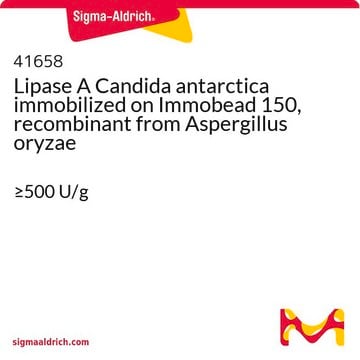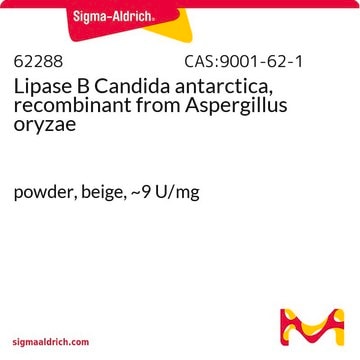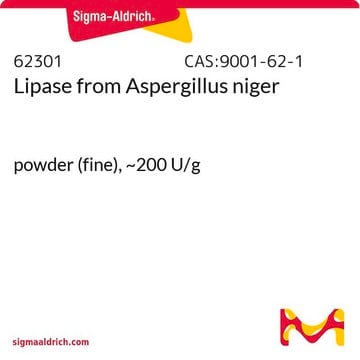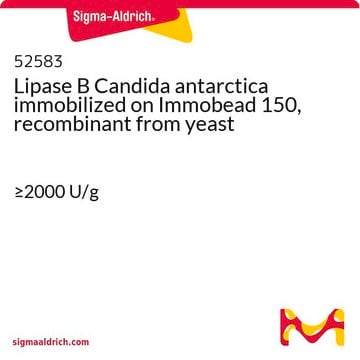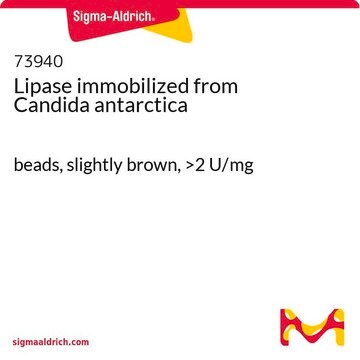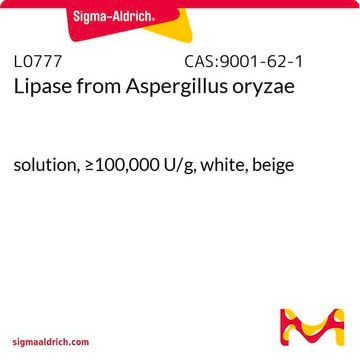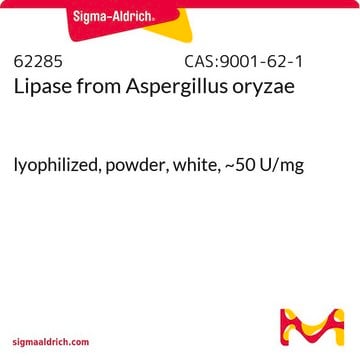62287
Lipase A Candida antarctica, recombinant from Aspergillus oryzae
powder, beige, ~2 U/mg
Sign Into View Organizational & Contract Pricing
All Photos(1)
About This Item
Recommended Products
recombinant
expressed in Aspergillus oryzae
Quality Level
form
powder
specific activity
~2 U/mg
shelf life
limited shelf life, expiry date on the label
color
beige
storage temp.
2-8°C
InChI
1S/C11H9N3O2.Na/c15-8-4-5-9(10(16)7-8)13-14-11-3-1-2-6-12-11;/h1-7,16H,(H,12,14);/q;+1/b13-9-;
InChI key
QWZUIMCIEOCSJF-CHHCPSLASA-N
Looking for similar products? Visit Product Comparison Guide
General description
Lipase A Candida antarctica (CALA) belongs to the α/β hydrolase family. The catalytic triad comprises Ser184, His366, and Asp334 residues.
application
Lipase A Candida antarctica, recombinant from Aspergillus oryzae has been used in the enzyme-catalyzed hydrolysis studies with 3-acetylthiohexanal. It has also been used as a biocatalyst to test its effect on the esterification of phytosterol with caprylic acid.
Biochem/physiol Actions
Lipase A Candida antarctica (CALA) is a thermostable serine hydrolase with a higher sn-2 preference towards triglycerides. It displays excellent activity towards large substrates as well as bulky sterically hindered tertiary alcohols.
Lipase A from Candida Antarctica catalyzes hydrolysis of tertiary alcohols to form glycerol and fatty acids and shows selectivity for the N-acylation of β-amino esters.
Unit Definition
1 U corresponds to the amount of enzyme which liberates 1 μmol oleic acid per minute at pH 8.0 and 40°C (triolein, Cat. No. 62314, as substrate); 1 U as described above is equivalent to ~0.15 U using trybutyrine, Cat. No. 91010, as substrate, at pH 8.0 and 70°C
Other Notes
Characterization
replaced by
Product No.
Description
Pricing
signalword
Danger
hcodes
pcodes
Hazard Classifications
Resp. Sens. 1
Storage Class
11 - Combustible Solids
wgk_germany
WGK 1
flash_point_f
Not applicable
flash_point_c
Not applicable
ppe
Eyeshields, Gloves, type N95 (US)
Choose from one of the most recent versions:
Already Own This Product?
Find documentation for the products that you have recently purchased in the Document Library.
Customers Also Viewed
Biotechnological relevance of the lipase A from Candida antarctica
Monteiro RRC, et al.
Catalysis Today, 362, 141-154 (2021)
Anders G Sandström et al.
Protein engineering, design & selection : PEDS, 22(7), 413-420 (2009-06-11)
We herein report the first directed evolution of Candida antarctica lipase A (CalA), employing a combinatorial active-site saturation test (CAST). Wild-type CalA has a modest E-value of 5.1 in kinetic resolution of 4-nitrophenyl 2-methylheptanoate. Enzyme variants were expressed in Pichia
Integrated enzymatic production of specific structured lipid and phytosterol ester compositions
Hellner G, et al.
Process. Biochem., 45(8), 1245-1250 (2010)
S.A. Patkar et al.
Indian Journal of Chemistry, 76-76 (1993)
Hidehiko Wakabayashi et al.
Journal of agricultural and food chemistry, 51(15), 4349-4355 (2003-07-10)
The enantioselectivity of the generation of 3-mercaptohexanal and 3-mercaptohexanol, two potent sulfur-containing aroma compounds, by lipase-catalyzed hydrolysis of the corresponding 3-acetylthioesters was investigated. The stereochemical course of the kinetic resolutions was followed by capillary gas chromatography using modified cyclodextrins as
Our team of scientists has experience in all areas of research including Life Science, Material Science, Chemical Synthesis, Chromatography, Analytical and many others.
Contact Technical Service